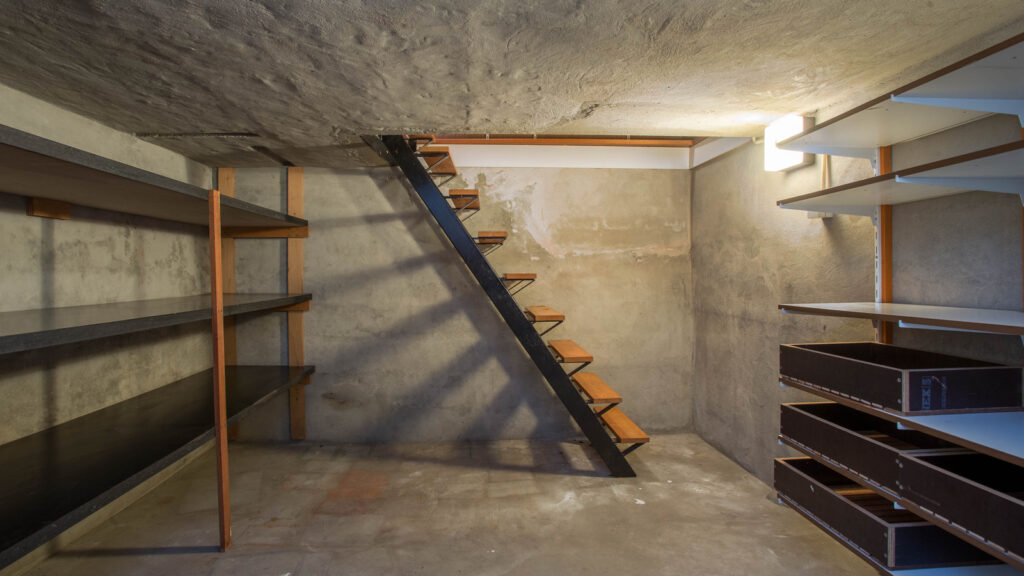After a long day you head down to your basement to grab a few things, as you descend the stairs you’re hit with a smell of must and mildew. It’s not the first time you’ve smelt it, but it’s enough to put you on edge knowing that the smell is coming from somewhere. Since you’re busy, it’s been easy enough to put off, but you know that sooner or later you’ll need to deal with it. Well, this is later, let’s walk through the six steps to get rid of that musty smell in your basement.
Look for Any Water Damage

source: pinterest.com
Have you ever had a flood or water damages in the past? If so, you should look out to find a few key things.
First, look for mold and mildew growth. You should be able see this growing on the wall and ceiling. It will show up as black, green or brown spots on drywall, along with appearing on clothing and furniture.
Second, check for leaks or dampness around the walls and floors. Wet spots or stains on the wall or floor can mean that water has been seeping into your home through cracks or holes in the wall or foundation.
Third, check for condensation on windows. In cold weather months, condensation indicates that there is moisture buildup in your home somewhere—perhaps even in your basement!
Fourth, check for water stains on the ceiling. These stains can indicate where water has been dripping into your home through cracks and holes in the roof.
Fifth, check for condensation anywhere else in your home. This can indicate that there is mold or mildew growing somewhere within your home.
Sixth, check for signs of flooding. Flooding can cause serious structural damage to your home, so make sure to check for signs of water damage such as water stains, puddles, or damaged carpet.
Seventh, check for signs of water intrusion. If you can see water stains on the ceiling, walls, or floor, then you know that water has been seeped into your home through cracks, holes, or faulty plumbing.
Eighth, check for signs of moisture intrusion. Moisture intrusion occurs when moisture enters your home through cracks or openings in the exterior siding of your home.
Ninth, check for signs of humidity intrusion. Humidity intrusion happens when moisture enters your home via air ducts or vents.
Tenth, check for signs of mold growth. Mold growth can occur in many places throughout your home, including the attic, crawlspace, garage, basement, bathroom, kitchen, laundry room, or living room.
If you notice a leak: Contact your local basement waterproofing and foundation repair experts to evaluate the damage.
Disinfect All Surfaces

source: thelist.com
It’s time to get to work after you’ve fixed the leak and cleaned up all the water damage. You must first thoroughly clean your basement. Scrub every surface in your home, including the furniture, walls, and floors, using a disinfecting cleanser.
Before allowing someone to touch them, make careful to completely dry them. To prevent re-infestation by moisture or precipitation on rainy days or during hot, humid weather, make sure to seal off any gaps and crevices near windows and doors. Dehumidifiers can be installed in areas like restrooms where high humidity levels encourage the growth of mold and other unwelcome pests.
Carefully Dry the Basement
If you have a damp basement, then you need to get rid of the moisture immediately. One way to do this is to install a dehumidifier. A dehumidifier works by sucking air through a filter and into an evaporator coil where it cools down and turns back into water vapor. When the water vapor condenses, it falls back into the evaporator coil and is pumped back into the room.
Dehumidifiers work great, but they require electricity. So, if you only have one outlet in your house, you may not be able to run a dehumidifier at once. In this case, you can try running a fan instead. Fans work by blowing warm air across a surface, causing it to cool off. They are much cheaper than dehumidifiers, though they won’t suck up as much moisture. Fans work better than dehumidifiers because they don’t require electricity. However, they aren’t perfect either. For example, if you live in a very humid climate, you might find that a fan just doesn’t cut it. In this case, installing a dehumidifier would probably be your best option.
Remove Moisture with a Dehumidifier or Fan

source: stinkstompersnevada.com
If your basement smells musty, you should first determine where the leak is coming from; if your roof, for instance, is the source of the leak, you may need to fix or replace it.
Next, go inside your home to see if there are any evident indications of wetness. If so, look into what led to the moisture building up in the first place.
Finally, remove carpets or rugs, clean up any trash on the floor, and run a fan over those areas for 15 minutes at least once every day to ensure sure there aren’t any sources of mold development hiding in corners or behind walls.
Keep the Basement Dry
Maintain a dry, well-ventilated and clean basement. Mold spores, which can be exceedingly deadly when inhaled, can be produced by having a messy basement with plenty of clutter. They are also a cause of the musty odor you are attempting to get rid of.
Keeping Your Basement Well Ventilated Will Keep It from Smelling Musty

source: pinterest.com
Open the outside-facing windows and doors frequently. In the summer, when it’s warmer outside than inside, this will prevent your basement from becoming stuffy.
To move air about the room, use a fan. You can utilize a portable fan or install one that is powered by electricity or batteries for constant usage (or both).
Use your dehumidifier if you have one as often as you can; don’t simply use it to dry up your basement! At first look, dry air may seem like a positive thing, but too much of it can sometimes result in mold development and other unpleasant odors. In order to avoid going against nature’s design principles, if you do have a dehumidifier, make sure that it is set to humidify rather than dehumidify (particularly during winter).
Conclusion
There are several steps you can take to remove the musty smell from your basement. It’s important to take action sooner rather than later as a musty smell can mean that there is mold growing which can be dangerous for your families’ health. In addition, it might mean there is a crack or leak in your foundation that needs fixing, especially as we are heading into the colder months. If you think you may have a mold problem, become familiar with possible mold symptoms and work with a trusted basement repair company to resolve the issue ASAP.



